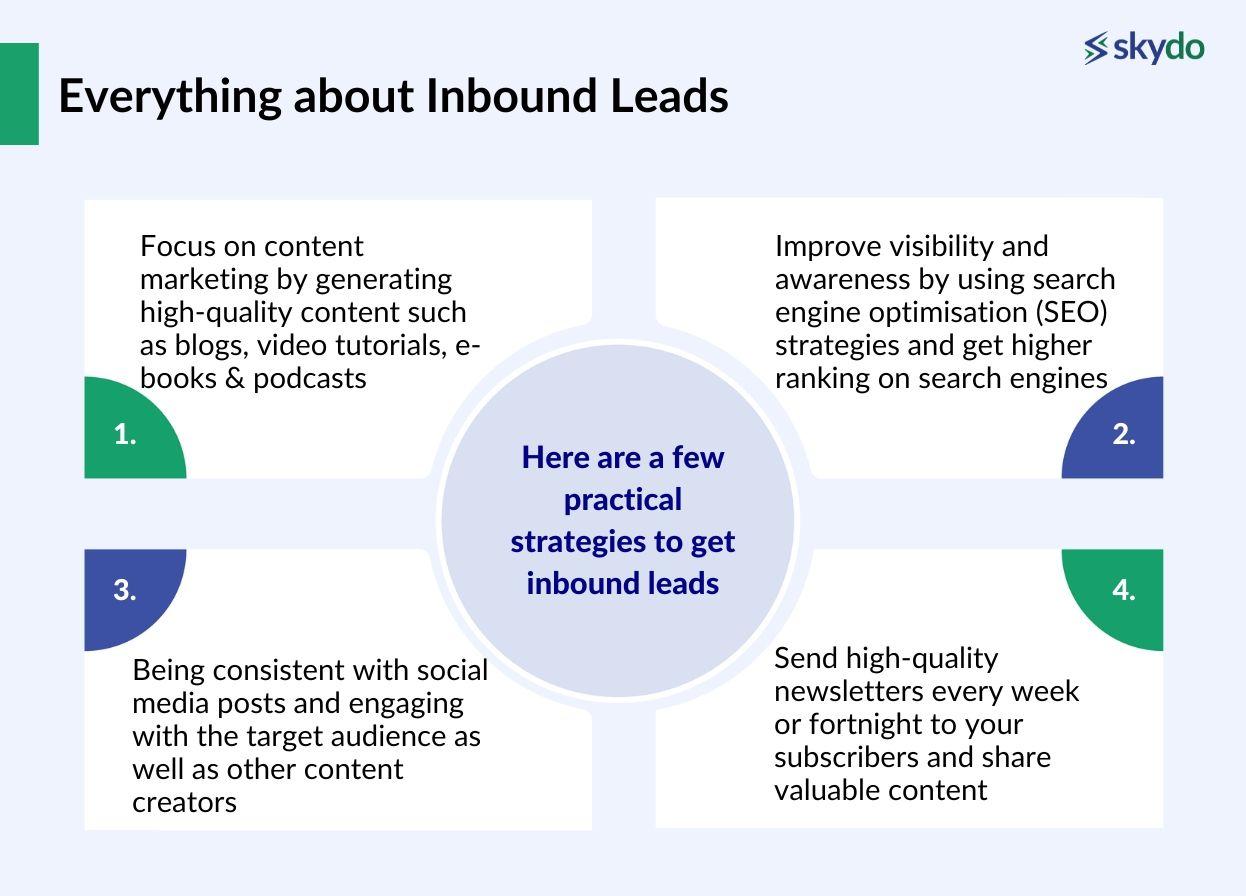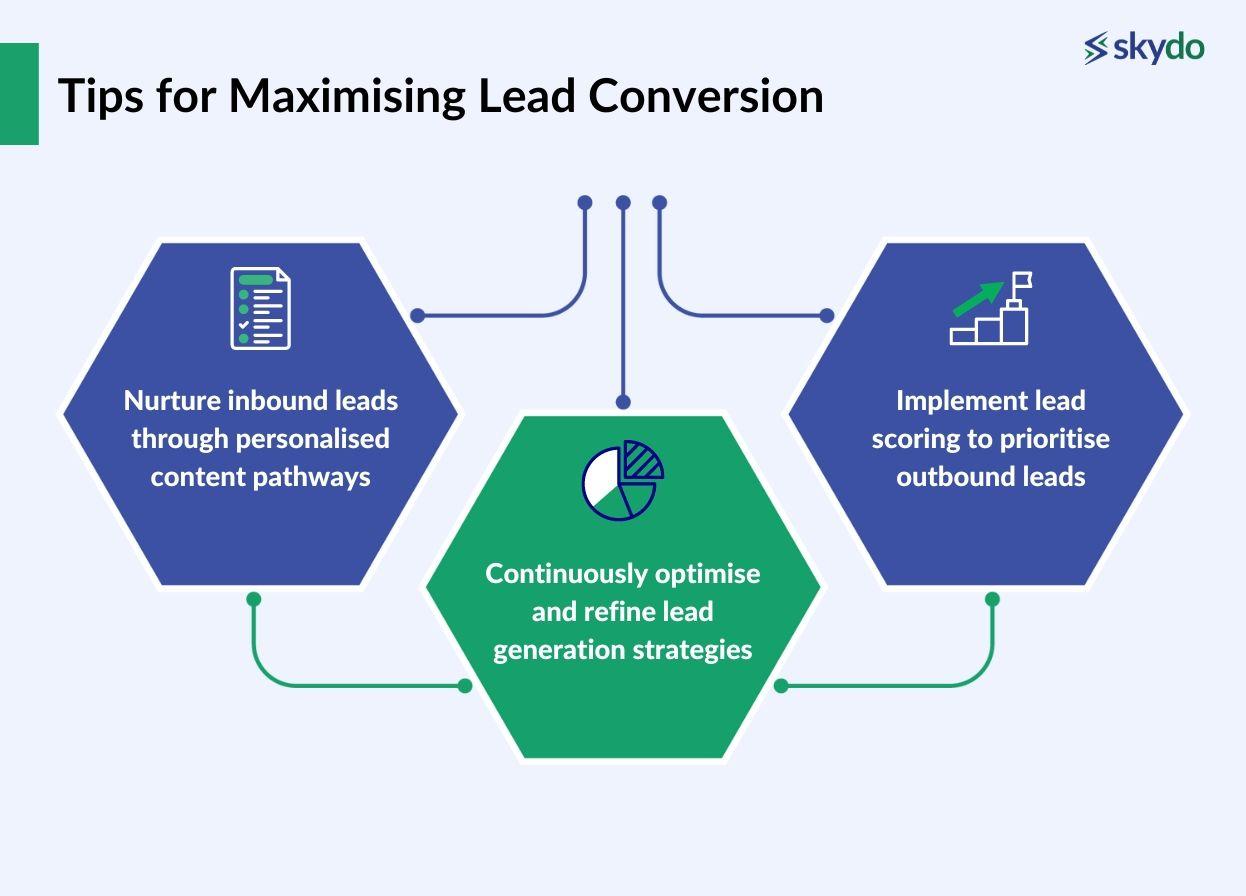Outbound vs. Inbound Leads: Which is best for Your Business?


"Customer service shouldn't just be a department; it should be the entire company", says Tony Hsieh, the CEO of Zappos, a shoe and clothing retailer company. The quote explains how the customers are the backbone of any business.
But how do you seek customers for your business? Through lead generation. This process involves building brand awareness and attracting potential leads which are then nurtured and converted into customers.
There are two ways: outbound leads and inbound leads.

Inbound leads revolve around creating content and strategies that naturally draw potential customers to your business. This includes methods like content marketing, social media engagement, and Search Engine Optimisation (SEO), which aim to make your business more discoverable to those already interested in your products or services.
Outbound leads involve actively reaching out to potential customers. This is often done through methods like cold calling, email marketing, or targeted advertising. In this case, you're contacting potential leads who may not have previously shown interest in your business.
61% of marketers consider lead generation as the most challenging task of growing a business. Therefore, organisations use multiple inbound and outbound lead generation strategies to increase business growth.
Let's delve deeper into how inbound vs. outbound lead generation works and how to optimise the lead generation and conversion process.
Everything About Inbound Leads
The term inbound marketing was introduced in 2005 by Brian Halligan and Dharmesh Shah in their book "Inbound Marketing". They explained that the way people want to communicate has undergone a massive revolution, and the modern way for businesses to get more customers is "instead of interrupting, work on attracting".
There is no doubt that the Internet has played a major role in transforming the shopping experience for people. However, the book explains that marketing is different because people have learned to block marketing calls and emails. Customers would rather do their research before buying a product instead of listening to a sales rep.
There are three main places people find information before making a purchase - Google search, the blogosphere (informational blogs published on websites), and the social media sphere, which comprises social media platforms like Instagram, Facebook, LinkedIn, YouTube, and X (previously Twitter).
Utilising these and other similar platforms to market your products are services is called inbound marketing. It focuses on marketing products in a way that appeals to potential customers.
Inbound leads meaning is the customers who find you, who are interested in your product and services and who want to buy them. Instead of you reaching out directly to the customers, inbound leads come to you.
But how does that happen? You create value for the customers and help them understand what your product or service can do for them.
How to Get Inbound Leads?
According to the author Marcus Sheridan, the mantra to understanding and succeeding in inbound marketing is "they ask, you answer". She explains this as a business philosophy which encompasses how you communicate with the customers, the company culture, and even how sales are made.
To get inbound leads, businesses have to act as teachers and be obsessed with how their customers are thinking, feeling, fearing, or asking. Essentially, you need to step into the shoes of the customer and think of all possible questions you can answer for them so that your business becomes the go-to source for them.
Keeping this philosophy in mind, here are a few practical strategies to get inbound leads.

- Focus on content marketing by generating high-quality content such as blogs, video tutorials, e-books and podcasts
- Improve visibility and awareness by using search engine optimisation (SEO) strategies and get higher ranking on search engines
- Being consistent with social media posts and engaging with the target audience as well as other content creators
- Send high-quality newsletters every week or fortnight to your subscribers and share valuable content
Benefits of Inbound Leads
Now you know what are inbound leads and how to build an inbound lead strategy, how does it impact your business? Let's understand.
- Higher conversion rates due to pre-existing interest
Inbound marketing offers better chances of lead conversion. The customer has approached you because they are already interested in your product or are at least aware of it. Now all you need to focus is on resolving any queries or reservations that they may have.
- Cost-effectiveness compared to outbound methods
One of the most significant pros of inbound that always stands out in the inbound vs. outbound leads debate is cost efficiency. Inbound leads can be generated through cost-effective channels such as an optimised website, SEO blogs and quality social media posts.
- Building trust and authority through valuable content
An inbound lead strategy helps businesses get prospective clients and enhances their overall brand reputation because your business becomes the go-to source for customers. This helps get client referrals.
Outbound Leads
As opposed to inbound marketing which uses a passive approach, outbound lead generation is a proactive strategy of reaching out directly to potential customers.
The purpose of outbound lead campaigns is to directly initiate communication with potential customers. It is also a quick way to increase awareness about your product.
How Outbound Leads Are Generated
Here is how you can leverage the latest technologies to execute successful outbound lead generation campaigns.

- Identify specific leads based on target demographics and market segments.
- Craft and send personalised and compelling messages with a clear call to action (CTA) through emails or social media platforms like LinkedIn.
- Leveraging technology such as email tools for automated email marketing and CRM tools for efficient outreach.
- Use strategies like cold calling, pay-per-view/click campaigns and running paid ad campaigns on LinkedIn, Facebook or Instagram.
Benefits of Outbound Leads
Even though outbound leads require more cost and resources compared to inbound leads, they are highly beneficial for businesses in the following ways.
- Control over lead volume and targeting
In outbound leads, businesses have complete control over whom they target and how much effort they put in. It enables businesses to control both the quality and quantity of leads based on a targeted approach.
- Immediate response and potential for quick results
Inbound marketing strategies like content marketing and email marketing can take some time to show results. However, outbound marketing often generates immediate results by encouraging people to take action.
- Effective for B2B and high-value sales scenarios
Outbound marketing campaigns are sent to targeted customers with specific messages to take action. Moreover, instead of waiting for potential customers to initiate communication, outbound lead generation involves taking a direct approach to making customers aware of your products. It helps build relationships faster and reduces the time required for lead conversion.
For example, imagine you're marketing specialised software to Fortune 500 companies. Outbound lead generation involves sending personalised emails and calls directly to decision-makers, showcasing your product's value.
This direct approach accelerates relationship-building, reducing lead conversion time and increasing high-value sales.
Inbound Leads Vs Outbound Leads
Here are the key differences between inbound vs. outbound leads:
| Aspect | Inbound Leads | Outbound Leads |
|---|---|---|
| Lead origin | It is initiated by the customer. | Businesses directly reach out to potential customers. |
| Engagement level | They have already a pre-developed interest and have higher engagement rates. | This has a low engagement rate because leads do not have much knowledge or understanding about the product/business. |
| Conversion rates | It has higher conversion rates because the lead has already engaged with the business. | Outbound leads have low conversion rates because customers are often unaware about the product and the engagement rate is low. |
| Approach | It uses an attraction and no interruption approach with an emphasis on creativity awareness about the product and educating the target audience. | This focuses on a proactive approach and requires teaching out to potential clients who may or may not be aware of your business. |
| Cost | These are more cost-effective as they generate leads organically through SEO, blogging, and social media marketing. | These are costly as they involve the use of various marketing tools to run personalised campaigns. |
| Metrics and KPIs | Inbound leads metrics include source of traffic, number of visitors on landing pages and the cost of acquiring inbound leads. | Its effectiveness can be measured by checking conversion rates, response rates to outreach campaigns, sales cycle length and the lead quality score. |
Choosing the Right Approach for Your Business
Businesses need to leverage various channels and platforms to get leads such as content marketing, social media marketing, email marketing, and more. However, the strategies must be tailored to your business needs. Here are a few effective tips to build a lead generation strategy.
- Understand your target audience and their preferences
The first step is to define your target audience and map their requirements and preferences. For example, if your target audience is middle-aged working professionals, email marketing and LinkedIn marketing might be the right channels to get leads.
- Align lead generation strategy with your business goals
Your lead generation strategy should be synchronised with your business goals. This facilitates the maximum utilisation of resources for relevant purposes. You can set key performance indicators (KPIs) to achieve specific business goals.
For example, if your ultimate goal is to boost revenue by 5x, your KPIs can include onboarding a customer for a specific transaction value.
- Assess available resources (budget, manpower, technology)
You need to check whether you have the right tools for marketing, campaign assessment, email tracking, and lead generation. Lead generation strategy and lead conversion require advanced knowledge of various marketing channels. It requires skill and sometimes even trial and error. Hence, you require a specific budget, tools, and manpower to execute a lead generation strategy.
You must pick the best lead generation tools, like HubSpot, that can automate various processes and boost efficiency.
- Combine inbound and outbound strategies for a holistic approach
Instead of deciding between inbound vs. outbound campaigns, you can combine both marketing strategies to get maximum benefits. These strategies include improving landing pages, circulating lead generation forms, running pay-per-click campaigns, offering giveaways, and writing quality SEO blogs.
Tips for Maximising Lead Conversion
Not all qualified leads can be successfully converted. The average lead conversion rate across 14 industries including agency, eCommerce, legal, tech, and finance is merely 2.9%. This means that out of every 100 leads, nearly 3 of them get converted. This explains how challenging lead conversion is.
Here are a few tips to help you maximise lead conversion:

1. Nurture inbound leads through personalised content pathways
To effectively nurture inbound leads, personalised content pathways are key. Personalised communication can increase lead conversion chances by 63%. Address your prospective customer’s pain points and offer tailored recommendations. Equally crucial is featuring personalised Call to Action (CTA) buttons on your website and social media content.
Some CTA examples that you can use are:
- Join Our Local Event/Community (for visitors from a specific location)
- Download our marketing toolkit to boost your revenue by X%
Utilising heat maps is another valuable tool. They visually show where leads tend to drop off on your web pages, helping you strategically place CTAs in those areas for improved engagement and lead conversion.
2. Implement lead scoring to prioritise outbound leads
Lead scoring is the process of ranking leads according to their characteristics, engagement rates such as email clicks or website visits, company size, and other factors.
It helps determine priority leads that have high conversion chances and focus on those leads. For the remaining leads, you can execute lead nurturing campaigns.
3. Continuously optimise and refine lead generation strategies
The most common way to test which strategy works better is A/B testing or split testing, which involves creating two separate versions of content and splitting your target audience into half. Now, display each version to one-half of the target audience. This helps determine which campaign or strategy can get better engagement and boost business growth.
Final Words
Lead generation is the cornerstone of customer acquisition. Understanding inbound and outbound methods is crucial for tailoring a successful strategy.
Inbound marketing focuses on organic attraction, leveraging content, SEO, and social media. It's cost-effective, with higher conversion rates.
Outbound lead generation is proactive and best for B2B and high-value sales. It offers control, quick results, and efficient engagement.
Combining both strategies maximises impact. To optimise lead conversion, focus on personalised content, lead scoring, and continual strategy improvement through A/B testing. Adapt your approach to align with your audience, business goals, and available resources for lasting growth.
Frequently Asked Questions
Q1. Who are inbound leads?
Ans: Inbound leads refer to potential customers who initiate contact with a business through various channels such as websites, social media, or content marketing. They express interest in the products or services offered without direct solicitation.
Q2. What are the key differences between outbound and inbound marketing?
Ans: Outbound marketing involves proactive outreach to potential customers, while inbound marketing focuses on attracting leads through content, SEO, and social media. Inbound is more permission-based, whereas outbound is interruptive.
Q3. What is the difference between inbound and outbound planning?
Ans: Inbound planning centres on creating content to attract leads naturally. Outbound planning involves strategic outreach through methods like cold calling or email campaigns to generate leads actively.
Q4. How quickly should you contact inbound leads?
Ans: Timely response is crucial. Ideally, contacting inbound leads within 24 hours maximises the chance of conversion, as their interest is fresh. Quick responses also enhance customer satisfaction.
Q5. How to increase inbound leads?
Ans: Boost inbound leads by optimising website content, employing SEO strategies, creating valuable and shareable content, using social media effectively, and implementing lead generation tactics like email marketing and webinars.












